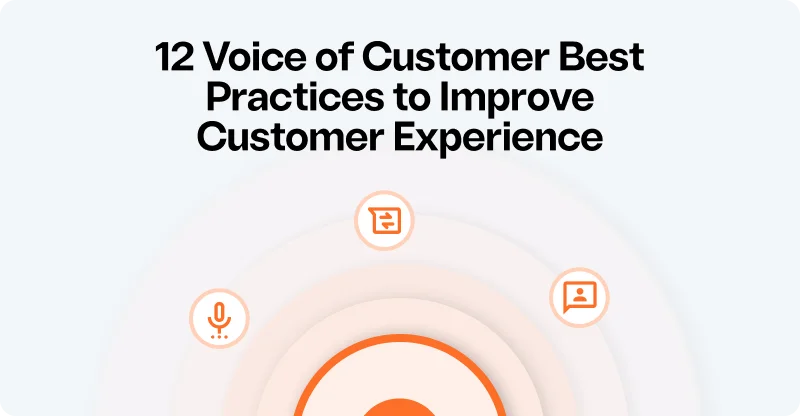Five Failure Modes to Watch This Holiday Season
- Checkout failures
Sudden dips in completed orders or clusters of “cannot place order” messages. - Payment friction
More customers saying “declined,” “verification not working,” or “card not going through.” - Post-purchase problems
Fast increases in “where is my order,” delays, or cancellations tied to one region or carrier. - UX and promo glitches
Short lived issues like “promo code not working” or pages freezing at checkout. - Support overflow
New issues rising inside ticket volume before dashboards show any warning.
If conversions dip while your dashboards still look healthy, you are already late.
During peak season, customers describe what is breaking 20 to 30 minutes before your tools detect it.
The teams that handle peak season best are not the ones with perfect systems.
They are the ones who:
- Spot problems early in what customers say
- Respond quickly with clear ownership
- Communicate calmly and consistently
The following guidance is based on patterns many CX and Ops teams see during peak season. Treat these as adaptable starting points and adjust for your own environment and workflows.
Before we dive in, it helps to remember that not every early warning shows up as a clear keyword. Customers often reveal problems through the tone and phrasing of their messages. These semantic cues can appear before the issue is named, so each section includes examples to help you spot them early.
1. Checkout failures customers never report
Silent checkout failures are one of the most expensive holiday issues. Customers rarely escalate them - they simply leave.
Signals to watch
• “cannot place order,” “stuck,” “error at checkout,” “place order keeps spinning”
• A small but sudden drop in completed orders
• Customers describing the same blocker in slightly different ways
Semantic cues
• “I am stuck at the final step”
• “I feel like I am going in circles”
• “It looks like it worked but nothing happens”
• “I filled everything in and the button will not move”
• “I am scared to try again in case it charges me twice”
These capture frustration and helplessness without naming “checkout error.”
Trigger to act (simple baseline)
If complaints double compared to your typical hour, or multiple similar comments appear within 10–15 minutes, treat it as an active issue.
First 10-minute actions
• CX: Validate by reviewing a handful of recent messages
• Product Tech Lead: Check if anything changed recently
• CX: Look for patterns by device, region, or browser
• Set a time for the next update
Also note: small login or password reset problems often appear as “checkout issues,” so include those in validation.
2. Payment declines and verification friction
During peak, payment flows tighten. More customers hit verification loops, bank declines, or unexpected errors.
Signals to watch
• “declined,” “bank won’t approve,” “card not going through,” “verification not working”
• Sudden friction in one region or one payment method
• Complaints clustering around a particular bank or card type
Semantic cues
• “I feel silly because my card works everywhere else”
• “It keeps sending me back to the same screen”
• “I have tried more than one card and none of them work”
• “I do not understand why I have to verify again”
These reveal friction and disbelief even when the customer does not use the word “decline.”
Trigger to act
A noticeable rise in payment-related feedback within 20–30 minutes, especially if it clusters around one method or region.
First 10-minute actions
• CX: Validate pattern in customer wording
• Payments Owner: Check if declines or verifications changed from usual levels
• Product: Confirm no recent adjustments to payment flows
• Set the next update time
Also note: gift card or store credit issues tend to spike on gifting days, and customers treat these as “payment problems.”
3. Post-purchase friction and cancellation surges
Fulfillment strain exposes issues with delivery expectations, inventory accuracy, and carrier performance.
Signals to watch
• Sharp rises in “where is my order,” “delayed,” “never received,” “cancel my order”
• Clusters tied to one carrier, warehouse, region, or product line
• Delivery dates appearing inconsistent or changing after checkout
Semantic cues
• “My tracking has not moved for days”
• “The delivery date changed after I bought it”
• “This was a gift and now I am worried it will not come in time”
• “Everything else arrived except this one thing”
These show anxiety and loss of trust before the customer explicitly says “delay.”
Trigger to act
If WISMO (Where Is My Order) questions or last-minute cancellations escalate 2-3x above your usual rate, or concentrate around one carrier/region, act quickly.
First 10-minute actions
• CX: Identify where complaints cluster (carrier, region, product line)
• Fulfillment Lead: Check carrier status and shipment updates
• Product: Check ETA logic or delivery messaging
• Set next update time
Also note: BOPIS (buy online, pick up in store) and address validation issues behave like post-purchase friction; they should be folded into this step.
4. UX or promo glitches that quietly increase abandonment
Short-lived UX slowdowns, promo misfires, or page inconsistencies rarely show up in analytics first. Customers feel them before tools record them.
Signals to watch
• “promo code not applying,” “page won’t load,” “keeps spinning,” “delivery date changed”
• Complaints clustering around one page (product, cart, checkout) or one device type
• Multiple customers mentioning the same promo or flow problem
Semantic cues
• “The page keeps resetting and I do not know if it is me”
• “The price says it should change but it stays the same”
• “On my phone it looks completely different”
• “I click continue and the screen flickers and goes back”
These expose subtle UX bugs and promo failures that analytics often miss.
Trigger to act
If several similar UX complaints appear within 20–30 minutes, or you see sudden frustration around a specific promotion, treat it as a live issue.
First 10-minute actions
• CX: Validate pattern across recent messages
• Product: Attempt to reproduce on common devices
• Marketing: Confirm promo setup and messaging
• Set next update time
Also note: promo stacking rules, last-minute cutoffs, and cached delivery messages frequently trigger these spikes.
5. Support overflow and the loss of early signals
Support teams notice problems first. During peak, they may be too overloaded to summarize or escalate patterns. This is the failure that hides all other failures.
Signals to watch
• A new issue showing up repeatedly inside an hour
• New themes suddenly entering the top five
• Agents escalating the same concern informally
Semantic cues
• “This has happened more than once today”
• “Is anyone else reporting this”
• “I keep running into the same problem”
• “I saw this earlier too”
These reveal that an issue has become frequent even before theme clustering catches it.
Trigger to act
If a new issue becomes one of the top frequent themes within 30 minutes, open an incident.
First 10-minute actions
• Incident Commander (CX): Summarize the issue in two sentences
• Analyst: Extract the top phrases and volume trend
• Product and Fulfillment: Rule out recent changes
• Set a cadence (every 15–30 minutes)
Also note: account access or login loops often appear here first, and they spike fast.
The rhythm that keeps teams aligned during peak, some ideas to consider
This rhythm helps teams spot issues sooner, stay aligned, and avoid blind spots during the busiest days of peak season.
Hourly (on peak days)
• CX Incident Commander posts the top three shifts in customer language
• Payments and Fulfilment share quick health snapshots
Daily
• Top three issues vs yesterday
• Product Lead confirms if anything has changed recently
• One stability signal (what has not changed)
• One new phrase to watch
Weekly
• The three most persistent concerns
• Owners, actions, and ETAs
• One cross-team dependency to resolve
These can keep teams coordinated without slowing them down. You can consider which other rhythms support your own scenarios and verticals based on these examples.
Copy and paste internal update template ideas
Here are ideas of how some teams set up their early warning signals. Use or adapt as needed.
What we’re seeing:
[Short description of issue] appearing in the last [time window]. Customer impact: [top phrases or simple trend].
What we’re doing:
[Owner] is taking [action]. Next update at [time].
Example
What we’re seeing: Checkout issues rising over the last 15 minutes. Customer impact: small dip in completed orders and 12 mentions of “spinning on place order.”
What we’re doing: CX validating patterns, Product checking recent changes. Next update at 12:45.
Quick revenue at risk check
One idea to quickly estimate impact:
Change in conversion × sessions during the window × average order value
This is not about perfect accuracy. It gives teams context to prioritize effectively.
Keyword watchlist ideas you could paste into your monitoring or Slack alerts
Here are some initial ideas; there are many more that may be relevant or stronger based on your specific market and offering.
Checkout
“cannot place order,” “stuck,” “error at checkout,” “spinning”
Payments
“declined,” “verification,” “card not going through,” “bank won’t approve”
UX / Promo
“promo code not working,” “page won’t load,” “delivery date changed”
Post-purchase
“where is my order,” “delayed,” “cancel my order,” “never received”
If you want a quick starting point, many teams prepare by:
- Paste the keyword watchlist into your VoC tool or alerting setup and route alerts to a shared peak-ops channel.
- Assign clear roles for incidents:
• Incident Commander (CX)
• Tech Lead (Product)
• Payments Lead
• Fulfillment Lead
• Analyst
• Comms - Agree on simple thresholds:
Act when customer complaints double vs your usual baseline or several similar mentions appear in 20 to 30 minutes. - Run one 10-minute dry run:
Pick “checkout issues,” practice posting the update template, and confirm who responds first.
These simple preparations can cut detection time, reduce debate, and keep teams aligned when volume surges.
Why prepared teams outperform perfect systems
Peak season rewards fast detection, clear communication, and calm coordination.
Customers do not expect perfection. They expect clarity and responsive support.
Visibility is not a dashboard. Visibility is a behavior.
The habit of noticing when customer language shifts and acting before the issue spreads.
With clear signals, steady thresholds, and a simple rhythm, any CX team can stay ahead of the holiday chaos.
Happy Holidays!
N.B. Every organization’s systems and thresholds behave differently, so use these examples as inspiration and tailor them to your internal environment and team’s judgment.
Heading 1
Heading 2
Heading 3
Heading 4
Heading 5
Heading 6
Lorem ipsum dolor sit amet, consectetur adipiscing elit, sed do eiusmod tempor incididunt ut labore et dolore magna aliqua. Ut enim ad minim veniam, quis nostrud exercitation ullamco laboris nisi ut aliquip ex ea commodo consequat. Duis aute irure dolor in reprehenderit in voluptate velit esse cillum dolore eu fugiat nulla pariatur.
Block quote
Ordered list
- Item 1
- Item 2
- Item 3
Unordered list
- Item A
- Item B
- Item C
Bold text
Emphasis
Superscript
Subscript

.webp)






.png)

.webp)
.svg)
.svg)







